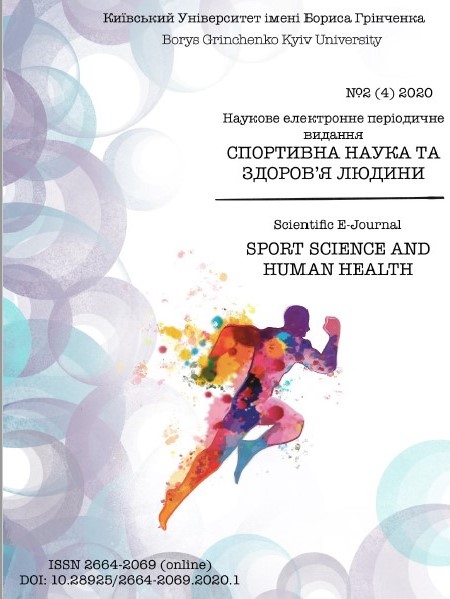ASSESSMENT OF THE RISK OF INJURY TO ATHLETES IN CONNECTION WITH PSYCHOPHYSIOLOGICAL INDICATORS (SKIING)
Ключові слова:
highly qualified athletes, state of psychophysiological functions, snowboarding, downhill skiing, cross-country skiingАнотація
Introduction. In modern sports, a high level of physical performance of the athlete is due to the functional properties and condition of all body systems. Of particular importance is the assessment of the functional state of the central nervous system. At the same time, the potential risk of injuries increases with each passing year, so one of the main tasks of sports physicians, psychologists, physiologists, especially in high-achievement sports, is to reduce injuries in sports.
The aim of the study was to compare the state of psychophysiological functions of highly qualified athletes who specialize in sports with varying degrees of extremeness (snowboarding, downhill skiing, cross-country skiing).
Material and methods. To determine the state of psychophysiological functions of athletes used diagnostic complex "Diagnostics-1" (MV Makarenko, VS Lyzogub). The group of respondents included qualified athletes engaged in skiing, characterized by the predominance of dynamic speed and a high probability of injury. These sports make special demands primarily on the central nervous system of athletes. In accordance with the purpose of the work, we studied the latent periods of simple visual-motor reaction, simple and complex reaction of choice, the efficiency of sensorimotor activity and the dynamics of nervous processes in the feedback mode, the accuracy of the reaction to a moving object and the ratio of reactions of advance and delay, dynamic muscular endurance of the right and left hands (according to the tapping test), as well as the basic properties of the nervous system namely the functional mobility of nervous processes and the strength of nervous processes.
Results. Athletes with a higher degree of extreme sports and risk of injury (snowboarders and skiers) showed a higher psychophysiological status in terms of strength of nervous processes and indicators of reaction to a moving object, a higher level of dynamic muscular endurance in terms of tapping test.
Conclusions. The identified differences in the state of psychophysiological functions in athletes with varying degrees of extreme sports activities and the level of risk of injury can have prognostic value and be used to optimize sports improvement in these sports.
Посилання
Vasylyuk VM. Forecasting the competitive activities of student-athletes. Visnyk Kam'yanetsʹ-Podilʹsʹkoho natsionalʹnoho universytetu imeni Ivana Ohiyenka. Fizychne vykhovannya, sport i zdorov'ya lyudyny, 2016; 9: 83-91. Ukrainian.
Holyaka SK. Properties of neurodynamic and psychomotor functions in students of different sports qualifications. Extended abstract of candidate’s thesis. Lviv; 2005. 18 p. Ukrainian.
Il'in YeP. Differential psychophysiology. SPb., 2001. 464 p. Russian.
Kutsenko TV. The state of primary school children’s psychophysiological functions. Extended abstract of candidate’s thesis. Kyiv, 2000. 18 p. Ukrainian.
Lyzohub VS, Kharchenko DM, Khomenko SM, Yukhymenko LI, Petrenko YUO, Yavnyk OE. Ontogenesis of human neurodynamic functions. Physiological Journal. 2002; 48 (2): 123-124. Ukrainian.
-Lysenko YeN, Shynkaruk OA. Influence on the manifestation of neurodynamic properties of athletes of sexual dimorphism and strenuous physical work. Science and Sport: Modern Trends. 2015; 6(1): 11-18. Russian.
Makarenko MV, Lyzohub VS, Bezkopyl'nyy OP. Methodical instructions to the practical works on differential psychophysiology and physiology of higher human nervous activity. Kyiv-Cherkasy, 2014. 102 p. Ukrainian.
Makarenko MV, Lizohub VS. Ontogenesis of psychophysiological functions of man. Cherkasy; 2011. 256 p. Ukrainian.
Makarenko N, Lizohub V, Bezkopyl'nyy A. Formation of the properties of neurodynamic functions in athletes. Science in Olympic sports. 2005; 2: 80-85. Russian.
Makarchuk MYu, Kutsenko TV, Kravchenko VI, Danylov SA. Psychophysiology: textbook. K.; 2011. 329 p. Ukrainian.
Platonov VN. Periodization of sports training. General theory and its practical application. K.: Olimp. literatura; 2013. 624 p. Russian.
Samoylov MH. Classification of sports according to the degree of extremity. Problemy ekstremalʹnoyi ta kryzovoyi psykholohiyi. Kharkiv; 2007; 3. Part. 2: 240-245. Ukrainian.
Solodkov AS, Sologub YeB. Human physiology. The total. Sports. Age: the Textbook. M., 2001. 620 p. Russian.
Тukayev SV, Dolgova ЕN, Ruzhenkova АО, Lysenko ЕN, Fedorchuk SV, Gavrilets YD, Rizun VV, Shynkaruk ОА. Typological and personality determinants of stress resistance in athletes of extreme sports events. Sports medicine and physical rehabilitation. 2017; 2: 8-15. Russian.
Shynkaruk O, Lysenko O, Fedorchuk S. Stress and his influence on the competitive and training activities of athletes. Fizychna kul'tura, sport ta zdorov'ya natsiyi: zbirnyk naukovykh prats'. 2017; 3(22): 469-476. Ukrainian.
Shynkaruk OA, Lysenko OM, Hunina LM, Karlenko VP, Zemtsova II, Olishevsʹkyy SV. Medicobiological support of training of athletes of national teams of Ukraine on Olympic sports. Kyiv: Olympic literature; 2009. 144 p. Ukrainian.
Breivik G. Trends in adventure sports in a post-modern society. Sport in Society. 2010; 13(2): 260–273. DOI: 10.1080/17430430903522970
Brymer E. Risk taking in extreme sports: A phenomenological perspective. Annals of Leisure Research. 2010; 13(1-2):218–238. DOI: 10.1080/11745398.2010.968 6845
Fedorchuk S, Lysenko E, Shynkaruk O. Constructive and non-constructive coping strategies and psychophysiological properties of elite athletes. European Psychiatry. 2019; 56: 306-307.
Fedorchuk S, Lysenko O, Romanyuk V. Neurodynamic properties and psychological characteristics of high qualification sportships with different sports trainings. Bulletin of Taras Shevchenko National University of Kyiv (Problems of Physiological Functions Regulation). 2018; 24(1): 27-31. DOI: 10.17721/2616_6410.2018.24.27-31
Kenney L, Wilmore J, Costill D. Physiology of Sport and Exercise. Champaign, Illinois: Human kinetics. 2015. 648 p.
Khan A et al. What physical activity contexts do adults with psychological distress prefer? Journal of science and medicine in sport. 2013; 16(5): 417-421.
Kolosova O, Khalyavka T, Fedorchuk S, Lysenko O. Indices of stress level and nerve conduction in qualified athletes. European Psychiatry. 2019; 56: 307.
Machado S et al. Neuroscience of exercise: association among neurobiological mechanisms and mental health. CNS Neurol. Disord. Drug Targets. 2015; 14: 1315-1316.
Makarowski R, Makarowski T, Smolicz M. Risk profiling of airline pilots: Experience, temperamental traits and aggression. J. of Air Transport Management. 2016; 57:298–305. DOI: 10.1016/j.jairtraman. 2016.08.013
Pedersen DM. Perceptions of high risk sports. Perceptual and motor skills. 1997. 85(2): 756-758. DOI: 10.2466/pms.1997.85.2.756
Renstrom PAFH. Sports injuries. 2002. 378 p.
Thorpe H. Berkshire encyclopedia of extreme sports. Berkshire Publishing Group, 2007.
Tukaiev S, Dolgova O, Van Den Tol AJM, Ruzhenkova A, Lysenko O, Fedorchuk S, Ivaskevych D, Shynkaruk O, Denysova L, Usychenko V, Iakovenko O, Byshevets N, Serhiyenko K, Voronova V. Individual psychological determinants of stress resistance in rock climbers. Journal of Physical Education and Sport. 2020; 20 (Supplement issue 1). Art. 69: 469-476. DOI:10.7752/jpes.2020.s1069
##submission.downloads##
Опубліковано
Як цитувати
Номер
Розділ
Ліцензія
Авторське право (c) 2021 Спортивна наука та здоров'я людини

Ця робота ліцензується відповідно до Creative Commons Attribution-NonCommercial-NoDerivatives 4.0 International License.











